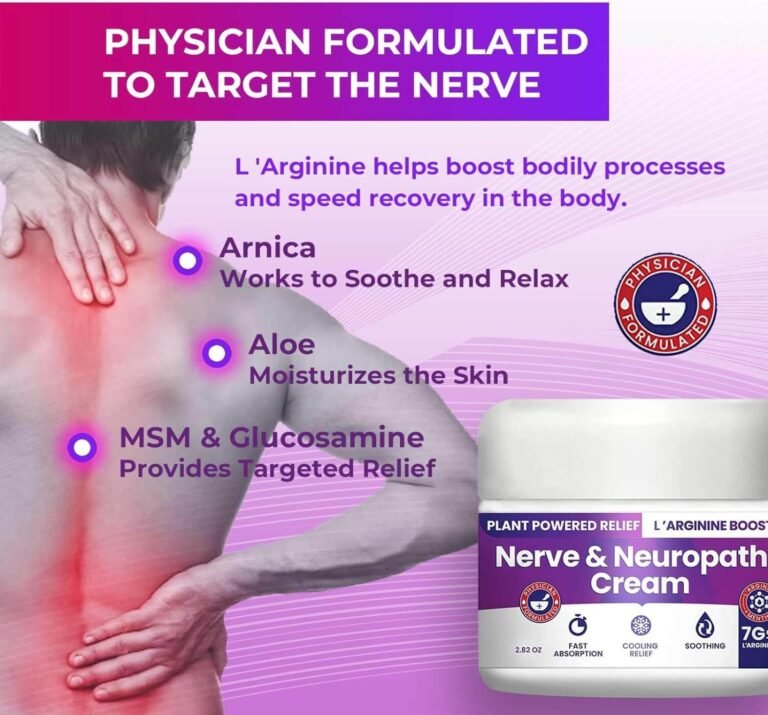The Power of Topical Analgesic Creams: Targeted Relief for Various
The Power of Topical Analgesic Creams: Targeted Relief for Various
Topical analgesic creams have emerged as an effective solution for targeted pain relief. Living with chronic pain can be debilitating, affecting your ability to perform daily tasks and enjoy life. While there are various pain management options available. These creams are designed to provide localized relief at the site of pain, making them an ideal option for managing chronic pain.
Topical analgesics come in various forms, including creams, gels, and ointments, making them easy to apply directly to the affected area. They contain active ingredients that work to relieve pain by blocking pain signals or reducing inflammation.
If you are experiencing chronic pain, topical analgesic creams may be a viable option for managing your symptoms. In the following sections, we will explore the benefits of using these creams, how they work to provide targeted relief, and the different types of topical analgesics available in the market.
Key Takeaways:
- Topical analgesic creams can provide targeted relief for various types of pain.
- They are an effective solution for managing chronic pain.
- Topical analgesics come in various forms and contain active ingredients that work to relieve pain.
Understanding Topical Analgesics and Their Mechanism of Action for Pain Relief
Topical analgesics are over-the-counter pain relievers that can be applied directly to the skin.
These analgesics work by blocking pain signals from the nerve endings located in the skin and underlying tissues. When applied topically, they can provide targeted relief for various types of pain, including muscle pain, arthritis, back pain, and more.
Topical analgesics are available in various forms such as creams, gels, and sprays. Creams and gels are the most common forms and are applied directly to the skin where the pain is felt.
Unlike oral pain relievers that are absorbed into the bloodstream and can cause side effects throughout the body, topical analgesics are only absorbed into the skin and provide localized relief without systemic side effects. As a result, they can be a safer alternative for those who cannot take oral pain medication.
Some topical analgesic creams contain additional ingredients such as menthol, capsaicin, and salicylate that can provide additional pain relief or a warming or cooling sensation.
Overall, topical analgesics are an effective and targeted way to manage pain, providing targeted relief without the risk of systemic side effects.
Targeted Relief for Acute and Chronic Pain
Topical analgesic creams can provide targeted relief for both acute and chronic pain. While acute pain is a normal sensation triggered by the nervous system to alert you to possible injury and the need for medical attention, chronic pain can persist long after an injury has healed, often lasting weeks, months, or even years.
According to the American Academy of Pain Medicine, chronic pain affects around 20% of adults in the US, with back pain being the most common form of chronic pain. While chronic pain can be difficult to manage, topical analgesic creams can provide localized relief without the systemic side effects that come with oral pain medication.
For acute pain, topical analgesic creams can provide immediate relief by targeting the affected area. They work by blocking pain signals to the brain, reducing inflammation, and increasing blood flow to the affected area.
For chronic pain, topical analgesic creams can provide ongoing relief, helping to manage pain over time. They can be used as part of a comprehensive pain management plan, reducing the need for oral pain medication that can have harmful side effects with long-term use.
Topical analgesics for acute can include lidocaine, capsaicin, and salicylates, while chronic pain in adults can be addressed with menthol and other cooling agents, counterirritants, and topical NSAIDs.
The Benefits of Topical Pain Relief Creams
Topical pain relief creams are a popular form of pain management, providing targeted relief for various types of pain. These creams are a preferred choice for many individuals due to their effectiveness in providing localized relief without the systemic side effects associated with oral pain medications.
One of the key benefits of using topical pain relief creams is their targeted nature. These creams are applied directly to the affected area, allowing for targeted relief at the source of pain. This is particularly advantageous for individuals experiencing localized pain, such as joint pain or muscle soreness.
Another benefit of topical pain relief creams is their ability to provide rapid pain relief. These creams are absorbed quickly by the skin and work directly at the site of pain, providing fast-acting relief. This is especially helpful for individuals experiencing acute pain, such as a sports injury or a recent surgery.
Additionally, topical pain relief creams can be used in conjunction with other forms of pain management. For individuals experiencing chronic pain, these creams can be used alongside oral pain medications or other treatments for more comprehensive pain management.
In summary, topical pain relief creams provide a safe and effective form of pain management that can be tailored to meet the needs of individuals experiencing various types of pain. With their targeted relief, rapid action, and ability to be used alongside other forms of pain management, these creams are a valuable tool for those seeking pain relief.
Exploring Different Types of Topical Analgesics
If you are looking for pain relief, topical analgesics can be a great option. These creams and other forms of topical pain medication can be applied directly to the affected area, providing targeted relief without the risks associated with oral pain medication. In this section, we will explore the different types of topical analgesics available and how they can help manage pain.
Topical NSAIDs
Topical NSAIDs are one of the most popular forms of topical analgesics. They work by reducing inflammation in the affected area, which can help alleviate pain. Some common topical NSAIDs include diclofenac, ketoprofen, and ibuprofen. These creams are often recommended for conditions like arthritis and sports injuries. However, it is important to note that topical NSAIDs may not be suitable for everyone and can have side effects.
Other Topical Pain Medications
Along with topical NSAIDs, there are other types of topical pain medication that can be effective in managing pain. These include lidocaine, capsaicin, and salicylate creams. Lidocaine is a numbing agent that can be applied to the skin to reduce pain. Capsaicin cream is made from chili peppers and can help alleviate pain by desensitizing nerve receptors. Salicylate creams are made from aspirin and can help reduce pain and inflammation.
Analgesic Creams
Analgesic creams are a type of topical pain medication that can help reduce pain and inflammation. These creams usually contain menthol, which can create a cooling or warming sensation that can help alleviate pain. Some analgesic creams also contain aspirin or methyl salicylate. These creams can be beneficial for conditions like muscle soreness, strains, and sprains.
Overall, topical analgesics can be an effective option for managing pain. Whether you are dealing with chronic pain or acute pain from an injury, there is likely a topical analgesic that can help. It is important to talk to your doctor before starting any new pain management regimen, as some topical analgesics may not be suitable for everyone.
Understanding the Active Ingredients in Topical Analgesics
When it comes to topical analgesic creams, understanding the active ingredients is key to choosing the right product for your pain. Here are some of the most common active ingredients found in topical analgesics:
| Active Ingredient | Pain-Relieving Properties | Potential Adverse Effects |
|---|---|---|
| NSAIDs (Nonsteroidal anti-inflammatory drugs) | Effective in reducing pain and inflammation | May cause skin irritation, rash, or itching |
| Capsaicin | Works by depleting the neurotransmitter substance P, reducing pain signals to the brain | May cause a burning or stinging sensation on the skin |
| Salicylate | Reduces pain and inflammation by inhibiting the production of prostaglandins | May cause skin irritation or rash |
| Menthol | Cooling and numbing sensation that reduces pain and discomfort | May cause skin irritation or rash |
| Diclofenac | NSAID that inhibits COX enzymes, reducing inflammation and pain | May cause skin irritation or rash |
| Methyl Salicylate | Reduces pain and inflammation by inhibiting the production of prostaglandins | May cause skin irritation, rash, or itching |
| Lidocaine | Blocks nerve signals, providing localized numbness and pain relief | May cause skin irritation, rash, or itching |
| Camphor | Provides cooling and numbing sensation to relieve pain | May cause skin irritation or rash |
It’s important to note that some active ingredients may be more effective than others for specific types of pain. Consult with your doctor or pharmacist to determine which active ingredient is most appropriate for your pain management needs.
Effective Use of Topical Analgesic Creams
When it comes to treating pain, topical analgesic creams can provide targeted relief to the affected area. However, to reap the benefits of these creams, it is important to use them effectively. Here are some tips for using topical analgesic creams:
- Follow the instructions on the package carefully.
- Make sure the affected area is clean and dry before applying the cream.
- Apply a small amount of cream directly to the affected area.
- Gently massage the cream into the skin until it is fully absorbed.
- Do not apply the cream to broken or irritated skin.
- Wash your hands after applying the cream.
It is important to note that topical analgesic creams are not a cure for pain, but rather a way to reduce it. If your pain persists or worsens, seek medical attention.
Overall, with proper application, topical analgesic creams can effectively treat pain and reduce discomfort in the affected area.
Topical Analgesics for Specific Pain Conditions
Topical analgesic creams can provide targeted relief for a range of pain conditions, including rheumatoid arthritis, joint pain, and neuropathic pain. These creams work by inhibiting pain signals at the site of application, offering localized relief without the systemic side effects associated with oral pain medication.
Rheumatoid arthritis is a chronic inflammatory condition that can cause joint pain, swelling, and stiffness. Topical analgesic creams that contain NSAIDs or capsaicin can be effective in providing relief for the pain associated with rheumatoid arthritis. These creams work by reducing inflammation and blocking pain signals in the affected joints.
Joint pain can be caused by a variety of factors, including injury, arthritis, and overuse. Topical analgesics that contain salicylate are often recommended for joint pain, as this ingredient can help reduce pain and inflammation in the affected area.
Neuropathic pain is a type of chronic pain that is caused by nerve damage. Topical analgesics that contain menthol or capsaicin can be effective in providing relief for neuropathic pain. These ingredients work by desensitizing the nerves in the affected area, reducing the amount of pain signals being sent to the brain.
Overall, topical analgesics can be a safe and effective option for managing pain associated with a variety of conditions. If you are experiencing pain, it is important to speak with your healthcare provider to determine the best course of treatment for your specific needs.
The Science behind Topical Analgesic Creams: An Overview of Cochrane Database of Systematic Reviews
When it comes to treating pain, topical analgesic creams have become increasingly popular due to their targeted relief and localized effects. However, many people wonder about the scientific evidence supporting the use of these creams. This is where the Cochrane database of systematic reviews comes in.
Cochrane reviews are systematic reviews of primary research in health care and health policy. They investigate the effects of interventions for prevention, treatment, and rehabilitation, and aim to provide evidence to inform decisions of health care providers, patients, and policy makers. In recent years, Cochrane reviews have investigated the efficacy and safety of topical analgesic creams for various pain conditions.
Overall, the evidence suggests that topical analgesic creams can provide effective pain relief for certain types of pain. For example, a Cochrane review of 13 studies found that topical NSAIDs were effective for relieving pain in adults with acute musculoskeletal pain. Another review of 34 studies found that topical capsaicin was effective for neuropathic pain, while a third review of 19 studies found that topical salicylate was effective for osteoarthritis pain.
However, it is important to note that not all Cochrane reviews have found topical analgesic creams to be effective. For example, a review of seven studies found insufficient evidence to recommend the use of topical NSAIDs for chronic musculoskeletal pain.
Despite these mixed findings, the Cochrane database of systematic reviews provides a valuable resource for understanding the scientific evidence behind topical analgesic creams. It highlights the importance of using evidence-based treatments for pain management and the need for further research in this area.
Conclusion
Topical analgesic creams are an effective and targeted form of pain relief that can help manage both acute and chronic pain. Whether you are suffering from joint pain, neuropathic pain, or rheumatoid arthritis, topical analgesics can provide localized relief without systemic side effects.
By understanding the active ingredients in these creams, such as NSAIDs, capsaicin, and menthol, you can choose the right topical analgesic for your specific pain condition. Additionally, effective use of these creams involves proper application techniques and direct application to the affected area.
Scientific evidence, including Cochrane reviews, supports the use of topical analgesic creams for pain relief. So why not explore the various options available and experience the power of these creams for yourself? Whether you prefer creams or gels, topical analgesics can provide effective pain relief.
So the next time you’re experiencing pain, don’t reach for systemic pain medication. Instead, try a targeted approach with topical analgesic creams to achieve the relief you need.
FAQ
Q: What are topical analgesic creams?
A: Topical analgesic creams are medicated creams that are applied to the skin to provide pain relief. They are designed to target specific areas of the body and can be effective in managing various types of pain.
Q: How do topical analgesic creams work?
A: Topical analgesic creams work by blocking pain signals in the body. They contain active ingredients that can penetrate the skin and reach the underlying tissues, where they help reduce inflammation and alleviate pain.
Q: What types of pain can topical analgesic creams target?
A: Topical analgesic creams can target both acute and chronic pain. They can be used for conditions such as muscle strains, joint pain, arthritis, and neuropathic pain. They provide localized relief directly to the affected area.
Q: What are the benefits of using topical pain relief creams?
A: Topical pain relief creams offer several advantages over other forms of pain management. They provide targeted relief to specific areas, without the systemic side effects associated with oral medications. They are also easy to apply and can be used as needed.
Q: What are the different types of topical analgesics available?
A: There are various types of topical analgesics available, including creams, ointments, gels, and patches. Some contain nonsteroidal anti-inflammatory drugs (NSAIDs), while others contain ingredients like capsaicin, salicylate, menthol, or methyl salicylate.
Q: What are the active ingredients in topical analgesics?
A: Topical analgesics may contain different active ingredients that provide pain relief. These can include NSAIDs like ibuprofen or diclofenac, capsaicin derived from chili peppers, salicylates like aspirin, menthol, or methyl salicylate.
Q: How should I use topical analgesic creams for maximum effectiveness?
A: To use topical analgesic creams effectively, it is important to follow the instructions provided. Clean and dry the affected area before application, and apply a thin layer of the cream. Gently massage it into the skin until fully absorbed. Repeat as necessary, but avoid exceeding the recommended dosage.
Q: Can topical analgesic creams be used for specific pain conditions?
A: Yes, topical analgesic creams can be beneficial for specific pain conditions such as rheumatoid arthritis, joint pain, and neuropathic pain. They can provide localized relief and help manage pain symptoms associated with these conditions.
Q: What scientific evidence supports the use of topical analgesic creams?
A: The efficacy and safety of topical analgesic creams have been supported by scientific studies, including Cochrane reviews. These reviews analyze data from multiple studies and provide an overview of the evidence supporting the use of topical analgesic creams for pain relief.





